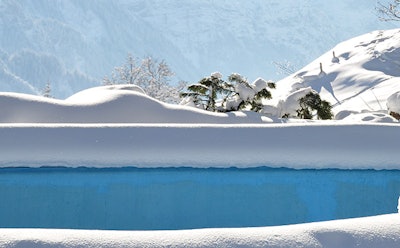
Among pool-loving homeowners in the North, instead of the traditional four seasons, there are only two. When the kids are splashing around in backyard, and the sunsets last forever, that's pool season. And then someone from the service company comes and works for a while in the backyard, heralding the second season, in which the pool is closed.
It's that simple for the homeowner. For them, the pool has been put on a shelf for six to eight months, after which it will be brought down, dusted off and brought to life again sometime before Memorial Day.
But the service person knows that a pool in winter is not a souvenir of good times that sits on a shelf, inert, until you reach for it again.
If winter conditions were consistent, if the temperature would simply drop to 20 degrees and stay there, that approach might work — but there are late winters, light winters, downright warm winters and winters that send temperatures fluctuating by more than 50 degrees in a continuous freeze-thaw cycle. So the best approach is to assume nothing and adjust to the manifest conditions.{bglink 5232}
The typical winterizing procedure includes chemical balance — pH between 7.2 and 7.6; total alkalinity between 80 to 120 ppm, calcium hardness 175 to 250 ppm — and either superchlorination or a good dose of chlorine-free shock. After chlorine levels come down (if a chlorine shock was used), a winterizing algaecide is added. A partial drain down may be included, along with a plumbing line blow-out to keep those pipes from freezing and cracking, a plug in the holes, a dose of pool-grade antifreeze and a cover over the pool surface.
RELATED: Arctic Exchange: Spa Maintenance in Cold Temps
That works fine in a winter that cooperates. But if an extended warm spell intercedes, some additional measures are required. Because those added chemicals don't care about your comfortable winter hibernation, they are breaking down according to their own schedules, and as they do, ever-present algae are pleased to take advantage. In areas that get a lot of acidic rain, a warm rainy winter may present a danger to plaster pool surfaces as well.
All this to say that despite the instinct to hibernate in winter which is so strong in northern regions, in the event of a protracted warm spell, a pool may need another visit for chlorine and algaecide, or just a chemical rebalance as insurance against the misfortune of a algae-filled, plaster-etched or wrinkled-liner opening.
In today's pool and spa industry, flexibility is more important than ever.
Need some winterizing products? Check out our roundup of winter safety covers, chemicals and more.
Winterizing TipOur winterizing tip comes from Steve White, owner and president of Underwater Pool Masters, West Boylston, Mass. White hates the very idea of wasting time draining down pools below the skimmer, so he uses the Gizzmo skimmer freeze protection device. It uses a sealed air cushion and a built-in blowout tube so you can blow out the lines without lowering the water level. "It really works and saves a ton of time," White says. "It's so easy to use, sometimes I just leave the Gizzmo with a customer and move on to the next pool." |











































